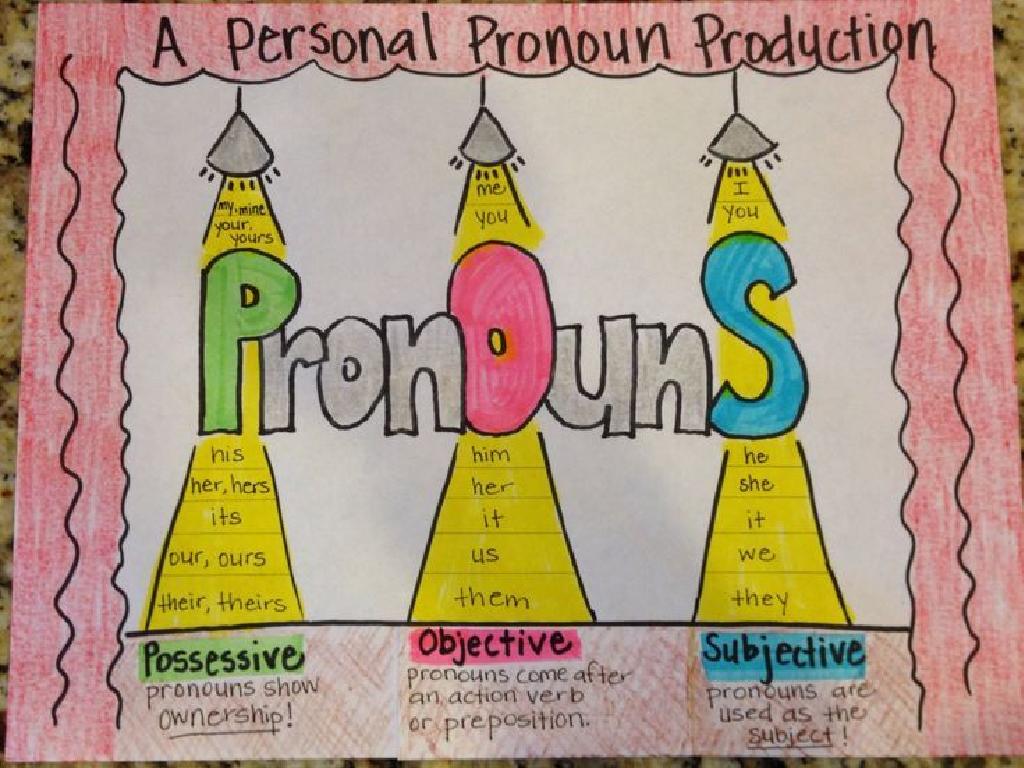Write Equations For Proportional Relationships From Tables
Subject: Math
Grade: Eighth grade
Topic: Proportional Relationships
Please LOG IN to download the presentation. Access is available to registered users only.
View More Content
Writing Equations for Proportional Relationships
– Define proportional relationships
– A relationship where two quantities increase at the same rate.
– Explore real-life proportions
– Examples: recipes, currency exchange, and distance-time relations.
– Learn to write equations from tables
– Use a table of values to form a proportional equation, y = kx.
– Today’s goal: Mastering equations
– Aim to confidently write proportional equations by the end of class.
|
Begin with a clear definition of proportional relationships, emphasizing the concept of constant rates of change. Provide relatable examples such as recipes (doubling ingredients for more servings), currency exchange rates, and distance-time relationships in travel to illustrate proportionality in everyday life. Teach students how to analyze tables of values to find the constant of proportionality (k) and write equations in the form y = kx. The goal for today’s lesson is for students to become proficient in translating tables into proportional equations, a key skill in understanding and applying proportional relationships in various contexts.
Understanding Proportional Relationships
– Define proportional relationship
– A relationship where two quantities increase or decrease at the same rate
– Explore constant of proportionality (k)
– ‘k’ is the ratio between two proportional quantities, y=kx
– Equations represent proportionality
– Use y=kx to write equations for proportional relationships
– Graphs & tables show relationships
– Visual aids to understand and interpret the constant k
|
This slide introduces the concept of proportional relationships, a fundamental topic in 8th-grade math. Begin by defining a proportional relationship as one where two quantities vary at a constant rate. Introduce the constant of proportionality, ‘k’, which is the consistent ratio in a proportional relationship, represented by the equation y=kx. Emphasize that equations, graphs, and tables are different ways to represent these relationships and help in understanding the concept. Provide examples of proportional relationships in tables and graphs, and demonstrate how to derive the equation. Encourage students to practice writing equations from given tables and graphs to solidify their understanding.
Identifying Proportional Relationships in Tables
– Signs of proportional relationships
– If every y/x ratio is the same, the relationship is proportional.
– Understanding the constant ratio (k)
– Constant ratio (k) is the same value for all pairs of x and y.
– Analyzing examples of proportional tables
– Example: Table with (2,4), (3,6), (4,8) shows k=2.
– Recognizing non-examples
– Non-example: Table with (2,4), (3,7), (4,9) isn’t proportional.
|
This slide aims to help students identify proportional relationships by analyzing tables. A proportional relationship exists when the ratio of y to x is constant across all pairs of data. This constant is known as k. Provide students with clear examples and non-examples of tables that represent proportional relationships. For instance, a table where each y value is double the x value has a constant ratio of 2, indicating a proportional relationship. Conversely, if the ratios are not consistent, the table does not represent a proportional relationship. Encourage students to practice with various tables to solidify their understanding of this concept.
Writing Equations from Proportional Tables
– Steps to find equations from tables
– Identify proportional relationships, then calculate the ratio of y to x for each pair.
– Determine the constant of proportionality (k)
– k is the ratio that is consistent across all pairs of numbers in the table.
– Formulate the equation y = kx
– Use the constant k to write the equation representing the relationship.
|
This slide aims to guide students through the process of writing equations for proportional relationships from tables. Start by explaining the steps to identify proportional relationships in a table by checking if the ratio of y to x is consistent for all pairs. Once the constant of proportionality (k) is found, students can then use it to write the equation in the form y = kx, where y is the dependent variable, and x is the independent variable. Emphasize that k must remain the same for all pairs of numbers in the table for the relationship to be proportional. Provide examples of tables with proportional relationships and practice finding k and writing the equations. Encourage students to work on several examples to gain confidence in identifying proportional relationships and formulating equations.
Writing Equations from Proportional Tables
– Analyze a practice table
– Calculate the constant (k)
– k is the ratio of y to x in the table
– Formulate the proportional equation
– Use y = kx to represent the relationship
– Example: Hours Worked vs. Earnings
– If 2 hrs = $30, then k = $15/hr
|
This slide is aimed at providing students with a step-by-step approach to writing equations for proportional relationships from tables. Start by analyzing a practice table together, identifying the x (independent variable) and y (dependent variable). Next, calculate the constant of proportionality (k), which is the ratio of y to x for all pairs in the table. Once k is determined, guide students to write the equation in the form y = kx, where y is the total, x is the number of units, and k is the constant of proportionality. Use a relatable example, such as hours worked and earnings, to illustrate the concept. For instance, if working 2 hours earns $30, then the constant k is $15 per hour. Encourage students to practice with additional examples and ensure they understand how to find k and write the equation.
Group Activity: Find the Equation!
– Break into small groups
– Each group gets a unique table
– Determine proportionality
– Check if the ratio between variables is constant
– Write the proportional equation
– Use y = kx, where k is the constant of proportionality
|
This group activity is designed to encourage collaborative learning as students work together to analyze tables and identify proportional relationships. Each group will receive a table with two variables. They must discuss and determine if the relationship is proportional by checking if the ratio between the two variables is constant across the table. If it is proportional, they will then write the equation in the form of y = kx, where k represents the constant of proportionality. Provide guidance on how to calculate k and how to apply it to write the equation. Encourage each group to explain their reasoning and how they arrived at their conclusion. This activity will help solidify their understanding of proportional relationships and how to represent them algebraically.
Class Discussion: Proportional Relationships
– Groups present their findings
– Discuss encountered challenges
– What difficulties did you face?
– Share effective strategies
– Which methods worked best?
– Reinforce proportionality concept
– Understand constant ratios in tables
|
This slide is meant to facilitate a class discussion where students will share their experiences and findings from their group work on proportional relationships from tables. Encourage each group to present their approach to writing equations for proportional relationships and the results they obtained. Open the floor for students to discuss any challenges they faced during the process and the strategies they employed to overcome them. Use this opportunity to reinforce the concept of proportionality, emphasizing the importance of a constant ratio in different tables. The teacher should guide the discussion, ensuring that key learning points are highlighted and that every student participates in the conversation. This collaborative review will help solidify their understanding of the topic and promote a supportive learning environment.
Individual Practice: Proportional Tables
– Complete the worksheet provided
– Write equations from each table
– For table with pairs (x, y), find constant k where y = kx
– Understand proportionality in equations
– Recognize y = kx represents a proportional relationship
– Get ready for a class discussion
|
This slide is aimed at reinforcing the students’ understanding of proportional relationships by having them practice with a worksheet. The worksheet will contain various tables where students must determine the equation that represents the proportional relationship between the two variables. They should identify the constant of proportionality (k) and express it in the form of y = kx. After completing the worksheet, students should be prepared to discuss their answers and reasoning in a class review session. This will allow them to learn from each other and clarify any misconceptions. The teacher should circulate the room, offering guidance and ensuring that students are correctly identifying the constant of proportionality and writing the equations.
Review and Reflect: Proportional Relationships
– Review worksheet answers collectively
– Discuss frequent errors and prevention
– Common mistakes: incorrect ratios or misinterpreting the table.
– Engage in a Q&A for extra clarity
– Encourage asking questions to clear up any confusion.
– Reflect on learning and understanding
|
This slide aims to consolidate the students’ understanding of writing equations for proportional relationships from tables. Begin by collectively going over the worksheet answers, ensuring that students understand each step taken to arrive at the correct equation. Highlight and discuss any common errors made, such as setting up ratios incorrectly or misreading values from the table, and provide strategies to avoid these mistakes in the future. Open the floor for a question and answer session, giving students the opportunity to seek additional clarification on any aspects they find challenging. Use this time to assess comprehension and to reinforce key concepts. Encourage students to reflect on what they’ve learned and how they can apply this knowledge to similar problems.
Class Activity: Crafting Proportional Tables
– Create your own table of values
– Confirm a proportional relationship
– Each row should maintain a constant ratio
– Write the equation for your table
– Use the formula y = kx, where k is the constant of proportionality
– Share and discuss with the class
|
This activity is designed to reinforce students’ understanding of proportional relationships and their ability to express them through equations. Students will apply their knowledge by creating a table of values that represents a proportional relationship. They should ensure that for every increase in the independent variable, the dependent variable increases at a constant rate, which is the constant of proportionality (k). Once the table is created, students will use it to write the corresponding equation in the form of y = kx. After completing their tables and equations, students will pair up to share their findings and discuss the different proportional relationships they’ve represented. This peer-to-peer interaction will help solidify their understanding and provide an opportunity for collaborative learning.
Lesson Summary & Homework
– Recap proportional relationships
– Homework: Real-life proportional examples
– Find everyday examples where quantities change in proportion
– Create tables and equations
– Use the examples to form tables, then write corresponding equations
– Preview of next topic
|
As we conclude today’s lesson on proportional relationships, remind students of the key concepts covered, such as constant rates of change and the relationship between quantities in proportional situations. For homework, students should identify real-life examples of proportional relationships, such as speed and travel time, or recipe ingredient adjustments. They are to create tables based on these relationships and then derive the equations that represent them. This exercise will reinforce their understanding and application of the concepts. In the next class, we will delve into a new topic, building upon the foundation laid today. Ensure students are clear on the expectations for their homework and encourage them to bring any questions to the next class.





